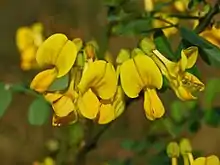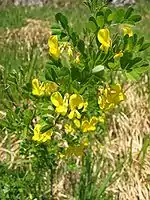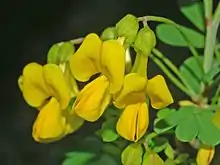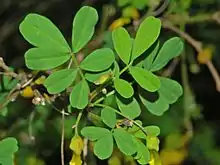Hippocrepis emerus
Hippocrepis emerus, the scorpion senna,[1] is a species of perennial plant belonging to the genus Hippocrepis in the family Fabaceae.
| Hippocrepis emerus | |
|---|---|
 | |
| Flowers of Hippocrepis emerus | |
| Scientific classification | |
| Kingdom: | Plantae |
| Clade: | Tracheophytes |
| Clade: | Angiosperms |
| Clade: | Eudicots |
| Clade: | Rosids |
| Order: | Fabales |
| Family: | Fabaceae |
| Genus: | Hippocrepis |
| Species: | H. emerus |
| Binomial name | |
| Hippocrepis emerus (L.) Lassen | |
| Synonyms | |
| |
Description
Hippocrepis emerus reaches on average 50–150 centimetres (20–59 in) of height, with a maximum of 200 centimetres (79 in). The plant has a lignified stem with green branches bearing five to nine leaflets. These leaves are glossy, obovate, and imparipinnate, with their maximum width being above the middle and often larger extremities. The pale yellow flowers are arranged in groups of 1 to 5, and measure 14–20 millimetres (0.55–0.79 in) long. The petals are "nailed", meaning they have a long handle ("nail") and a "plate". The nails of the petals are two to three times longer than the calyx. These plants are hermaphroditic and entomophilous, and their flowering period extends from April through July. Their legumes (seed pods) are oblong-cylindrical and 5–11 centimetres (2.0–4.3 in) long, with three to twelve segments.
Distribution
This plant occurs in northeastern Spain and in central Mediterranean countries up to northern Europe and to Asia Minor and Tunisia.
Habitat
These shrubs are usually found in wooded and bushy areas, on sunny, warm and dry slopes and around forest edges. They can be found at an altitude of 0–1,850 metres (0–6,070 ft).
Food source
H. emerus is one of the main host plants of the moth Zygaena ephialtes. [2]
Gallery
 Plant of Hippocrepis emerus |
 Flowers of Hippocrepis emerus |
 Leaves of Hippocrepis emerus |
 Fruits of Hippocrepis emerus |
References
- "BSBI List 2007". Botanical Society of Britain and Ireland. Archived from the original (xls) on 2015-01-25. Retrieved 2014-10-17.
- "Habitat requirements of conspicuous burnet moth Zygaena ephialtes (Linnaeus, 1767; Lepidoptera: Zygaenidae) (PDF Download Available)". ResearchGate. Retrieved 2017-11-16.
- Pignatti S. - Flora d'Italia - Edagricole – 1982. vol. III
- Tutin, T. G., eds. 1964 -1980 - Flora europaea